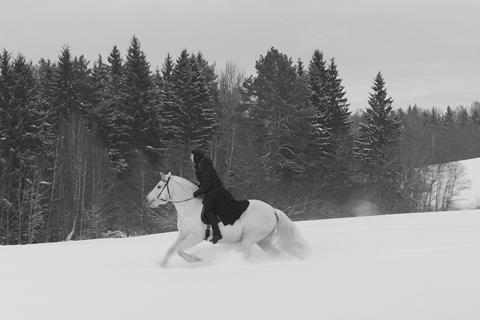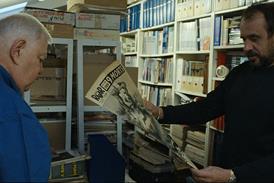A Belorusian convent is the setting for this unique UK-produced story of spiritual self-realisation

Dir. Cécile Embleton, Alys Tomlinson. UK. 2024. 91 mins.
The phrase ‘stranger than fiction’ is to be handled with care, but one suspects that it not infrequently applies to the paths leading individuals to the life monastic. That is certainly the case with Mother Vera, premiering in Visions du Réel – a portrait of a Belorusian nun, the world she inhabits and her singularly fraught journey of self-realisation.
Transfixingly beautiful film… is a must for festivals
Shot in black and white with a coda in colour, this transfixingly beautiful film is a documentary, but imbued with the contemplative narrative drift associated with ‘slow cinema’ fictions. It will be a must for festivals, especially any with feminist or ecumenical interests; as a portrait of female spiritual issues, it could have similar distribution potential to recent art-house hit Smoke Sauna Sisterhood, as well as tapping the congregation that flocked to 2005 monastic documentary In Great Silence.
Mother Vera is a debut for both its directors – French-British documentarist Cécile Embleton, whose shorts include 2016’s The Watchmaker, and acclaimed British photographer Alys Tomlinson, whose religiously-themed photo project ’Ex-Voto’ (2019) was the starting point for this study.
The film begins with a long take following an unidentified figure pacing up corridors and staircases in a heavy black robe, before falling to the floor kneeling in such a way that person and robe seem to be one single mass. A long sequence of impressionistic chiaroscuro images follows – candles in darkness, metal balustrades, crowds of figures in monastic cloaks with the distinctive flat-topped Orthodox headpieces – then the sound of cantillation, a ringing chant on one monotone but reverberant note. With Leonardo Cautereccio’s spare sonic texturing (bells, wind, horses’ hooves, voices), Mother Vera communicates as richly in sound, and indeed silence, as it does in images.
When the film’s central figure fully comes into focus, it is as a face hovering in darkness, her pale, gentle features standing out from the darkness of her cowl, making her resemble one of the painted icons seen throughout the film. She is a nun,m Mother Vera, who is then seen riding a white horse through snowy fields. Nearly everything up to this point could suggest a fictional reconstruction of the distant past: Tarkovsky’s Andrei Rublev inescapably comes to mind. But then it becomes clear that we are in the present day, as we see a Christmas social event at which Vera and other nuns and priests interact with local people, including a young man with Down’s Syndrome.
in brief sections of voice-over in the Belorusian language – delivered confessional-style in gentle sotto voce - Vera reveals her past and explains what brought her to the convent (although not specified, it is situated in Belorusia, near Minsk). At the age of 20, she lived a worldly life that involved nightclubs, motorbikes and a criminal husband, Oleg, whom she says went to prison because of her. She confesses that she robbed, destroyed people’s lives, got other girls hooked on drugs; even today, after 20 years of monastic life, she says, “I must be from hell”. In a remarkable passage, she describes her heroin use almost in terms of religious transcendence, before revealing how the drug then showed her its demonic side.
This convergence of high spirituality and underworld degradation – a theme with particular Slavic, not to say Dostoevskian, resonance - comes into focus at a meeting attended by a roomful of men who, we learn, are at the monastery for rehabilitation. They are ex-convicts who talk about the pariah status of prisoners seen as weak (‘downcasts’, as the subtitles put it), before a priest sternly addresses them on all being equal before God. The scene also features sly asides between Vera and another nun; saintliness notwithstanding, the latter gets positively flirty in her observations of some of the men present.
Vera, named Olga in her previous life, is also seen with her family - mother, sister and nephews. In an irresistible sequence, she and her sister take a walk through a pine forest, together with a donkey, its foal and a young sheep, the latter two irrepressibly larky.
Shot by both directors, the film is rich in single images that stand out with poetic intensity, sometimes held, sometimes fleeting: a close-up of Vera’s hand fingering a rosary, a shot of a monastery window that could be a mediaeval scene, if not for the industrial chimneys visible on the horizon. The dominant mode is a highly textured, sometimes frosty range of greys, recalling Bela Tarr’s later films, but with stark contrast in some sequences, both in the chiaroscuro interiors and in the shots of black-cloaked Vera galloping across fields of snow.
Then, some 20 minutes before the end, the film gently transitions into colour, and seems to become a different film entirely – following Olga/Vera into a very different world and discipline. No spoilers here, except to say that it becomes clear that her personal quest through secular and religious worlds is far from over.
Production company: She Makes Productions
International sales: She Makes Productions, laura@shemakesproductions.com
Producer: Laura Shacham
Cinematography: Cécile Embleton, Alys Tomlinson
Editors: Romain Beck, Cécile Embleton

























No comments yet